-
Posts
1,283 -
Joined
-
Last visited
Content Type
Profiles
Forums
Developer Articles
KSP2 Release Notes
Bug Reports
Posts posted by SQUAD
-
-
-
各位坎巴拉宇航员,大家好!
为了分享我们对太空的热爱并将《坎巴拉太空计划》带给更多的玩家,我们很高兴在此宣布通过中华人民共和国国家新闻出版署审批的《坎巴拉太空计划》即将登陆国区,并于2021年2月2日在WeGame平台正式发售。为庆祝正式发布,我们届时将于限定期间内以首发折扣价25人民币(即二五折价格)出售这款游戏。
请前往WeGame观看官方预告片
在发布后的数周内,我们将会推出补丁,为游戏整合加入UserSpace,提供查看与分享游戏内及WeGame平台上模组文件的功能。请放心,我们正在持续探索在WeGame平台上进一步提供《坎巴拉太空计划》更新版本的可能性;若有消息,我们会尽快通知大家。
我们非常高兴能够目睹《坎巴拉太空计划》大家庭的成长,以及全球太空探索者和狂热科学迷社群的持续扩展。
祝您欢乐起航!
-
Join us this upcoming Wednesday at our Twitch channel - KSPTV - and let's play and talk some KSP: Shared Horizons!
17:00 EDT
14:00 PDT
23:00 CET
Featuring:
@Just Jim
@technicalfool
@Maxsimal
@UomoCapra
See you there and happy launchings! -

Welcome to our official newsletter, KSP Loading…! If you want to learn about all the current developments of the KSP franchise, then this is the place to be!
Kerbal Space Program Update 1.9 on PC
Another orbital period has completed, and as human tradition has it, it’s a good time to reflect on past achievements as well as look forward to goals we set for ourselves during this new decade. 2019 was a great year for us: We released several major updates and a content-filled expansion on PC. KSP Enhanced Edition also got some deserved attention with the History and Parts Pack and the Breaking Ground Expansion, as well as a considerable amount of free content. Not too shabby, right? And 2020 is looking great for KSP fans, too! For starters, we’re kicking off the new year with update 1.9, which will not only include performance and graphical improvements, but some new neat features that we’re excited to show you. Not to mention Kerbal Space Program 2 and some other stellar surprises we have currently in the VAB for you. For the time being, and for this KSP Loading in particular, we’re going to focus on some of the stuff that is going to roll onto the launchpad in Kerbal Space Program 1.9: No Place Like Home! So buckle up:

Terrain Revamp for Kerbin
In addition to the revamps of Moho and Dres that we’ve shown you already, Kerbin has received major visual improvements. With detailed high-quality texture maps and (because there is no place like home) an Ultra Quality shader option, the Kerbal home planet is looking better than ever. Check it out!
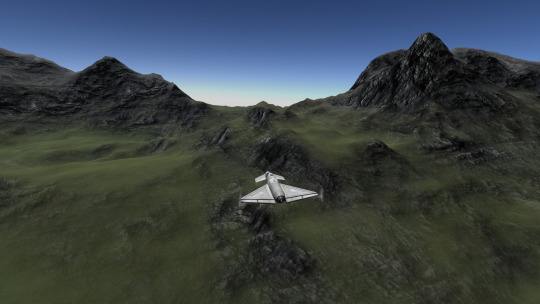
Click here to see the full hi-res gallery
Drain Valve
Kerbal Space Program 1.9: No Place Like Home! will also include a new part that works as a release valve for parts with drainable resources, such as monopropellant, ore, liquid fuel, oxidizer or xenon. This part will also allow you to set the drainage over a specific amount of time, a feature that will undoubtedly come in handy.

Click here to see a high-res image.
Part Revamps
RE-M3 “Mainsail” Liquid Fuel Engine
One of the heaviest and most powerful large-diameter Kerbal engines is getting a well-deserved makeover. We’re talking, of course, about the Rockomax Conglomerate’s RE-M3 “Mainsail” Liquid Fuel Engine. With its new geometry, textures and emissive map, this humongous engine has never looked so good. Additionally after listening to your feedback, we’re including Mid and Bare variants.
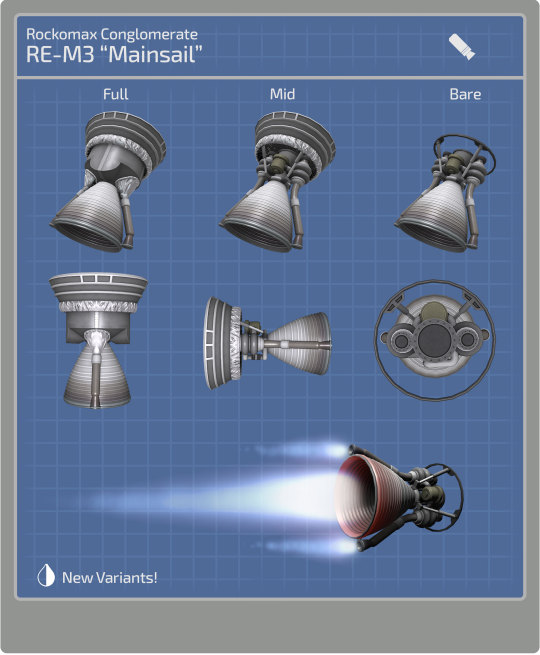
Click here to see high res images.
RE-I5 “Skipper” Liquid Fuel Engine
Rockomax Conglomerate’s RE-I5 “Skipper” Liquid Fuel Engine has also been modernized by our art team. Brand new geometry, variants, textures and emissive maps have given one of our favorite medium sized engines a befitting fresh new look! And after listening to your feedback, we’ll be including Bare and Truss Mount variants.
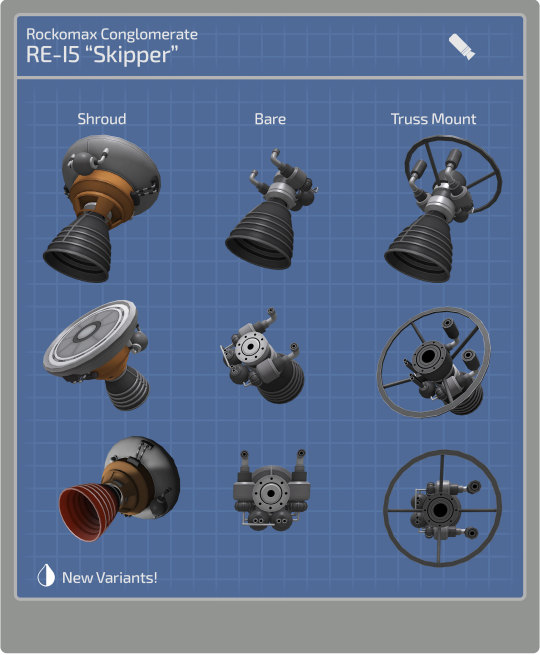
Click here to see high res images.
BACC “Thumper” Solid Fuel Booster
With reliable performance at a good price, the Rockomax Conglomerate’s BACC Solid Fuel Boosters have always been a popular choice to get the massive bulk of large multi-stage rockets off the ground. This large SRB is finally getting a physical renewal to better match its place in our SRB lineup. Check it out!

Click here to see high res images.
Quality of Life Features
Additionally, Kerbal Space Program 1.9: No Place Like Home! will include several quality of life features, mostly drawn from our players’ feedback. Some of the inclusions are: an adjustment to the time warp system that removes restrictions on warping at certain altitudes; a new cheat menu option that will allow you to place your craft above the surface of any celestial body; a search box for the R&D Tech Tree; and a new Screenshot Mode that will allow you to pause the game, move the camera and take the best shot by hitting the Escape key and then F2. There are several more QoL features we’re sure you’ll appreciate, too!
Blade improvements
Rotor blades in the Breaking Ground Expansion are getting some improvements by adding cyclic and collective deflection controls. This will ultimately help players have better control of their bladed vehicles, whether it is a traditional single-rotor helicopter or a drone-like quad-copter. There’ll be a Devblog explaining the details about these improvements coming up soon, so stay tuned.
New Stock Craft for Expansions
With this update, we are also including a few new stock craft that take advantage of Breaking Ground’s parts and demonstrate how we used the new blade functionality! We’ve also added easy access to some of the historical craft from Making History. So, if you just want to pilot cool crafts or retro-engineer the heck out of them to create your own, you’ll surely enjoy these; we certainly had a lot of fun building and testing them!
Remember, you can share and download crafts and missions on Curse, KerbalX, the KSP Forum and the KSP Steam Workshop.
That’s it for this edition. Be sure to join us on our official forums, and don’t forget to follow us on Twitter, Instagram and Facebook. Stay tuned for more exciting and upcoming news and development updates!
Happy launchings!
-

Welcome to our official newsletter, KSP Loading…! If you want to learn about all the current developments of the KSP franchise, then this is the place to be!
Kerbal Space Program Update 1.9 on PC
The KSP team is so excited about the features being worked on for Update 1.9. Similar to the last update, 1.9 will focus on furthering the performance and graphical improvements to the foundations of the game. These improvements include: new textures and mappings for Celestial Bodies, new shaders, optimizations, additional revamps and much more. Our goal for update 1.9 will be to continue to build upon the foundations that make KSP great.
Terrain Revamp for Moho and Dres
We’re continuing to revamp our celestial bodies, and in 1.9, Moho and Dres are getting fresh high-quality texture maps & graphic shaders. Take a look!
KSP breaks ground on consoles!
As we announced recently, Breaking Ground, the second expansion of Kerbal Space Program Enhanced Edition is coming to PlayStation 4 and Xbox One on December 5th and it will have 100% feature parity with its PC counterpart.
Kerbal Space Program Enhanced Edition: Breaking Ground is all about exploration, experimentation and technological breakthroughs. With this expansion console players will be able to discover mysterious surface features across the moons and planets of the Kerbolar System. Players will also have the ability to collect data with brand new deployable experiments and design complex crafts with the addition of robotic parts.
Deployed Science
This feature will allow you to deploy experiments on the surface of celestial bodies to take measurements over time. You will need to bring these experiments with you, unpack them from storage containers on your craft and set them up to run. In order to do so, you will need to place a central station, one or more power generating devices and possibly a booster antenna to get your science base set up. The experiments and power generators will run better if the right kind of Kerbal sets them up, thus giving you more reasons to bring Kerbals with different professions on an adventure.
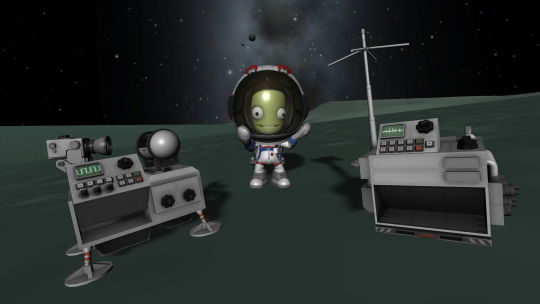
Click here to see the different experiments that will be available in Kerbal Space Program Enhanced Edition: Breaking Ground
Surface Features
Surface features are items of scientific interest scattered across all celestial bodies. These features include meteorites, craters, mineral formations, and even stranger planetary oddities. Surface features vary in size and Kerbal astronauts will be able to pick up and return the smallest of them to study back at KSC. However, larger specimens will need to be scanned and analyzed on-site by the newly developed Rover Arms. The Rover Arms come in three levels that you unlock via Research and Development, each of which have more sensors and tools that allow you to collect more science from the same surface feature.
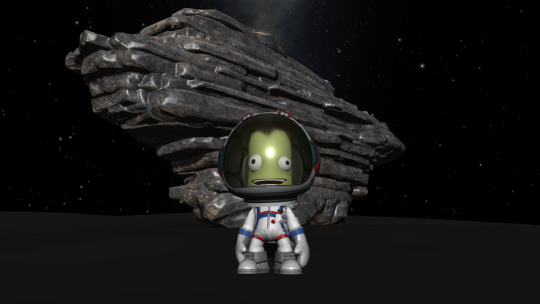

Click here to see more images of Surface Features and the Rover Arm in high-res.
Robotics
With Breaking Ground, you will see a number of robotic parts including: hinges, pistons, rotors, rotational servos, propeller blades and turbo-shaft engines. Available in a range of shapes and sizes these new parts operate under realistic physics, with real forces and torques, electricity consumption and even motor mass accounted for.
We are also including a controller part that will let you coordinate the behavior of many different parts on your craft. Use Hinges to provide angles of rotation between two parts. Pistons give you linear motion. Rotors will allow you to generate torque around their axis. Rotational servos will give you precise control of angular position. Propeller Blades and Turbo-shaft Engines will allow you to build helicopters and other blade-propelled contraptions.
The KAL-1000 controller can sequence the actions of all the robotics parts and a number of other fields. It gives you access to a powerful track editor tool which lets you plan how parts will behave over time. Using this controller, you can set up complex cranes, walking crafts, disco lighting or whatever you can dream up!
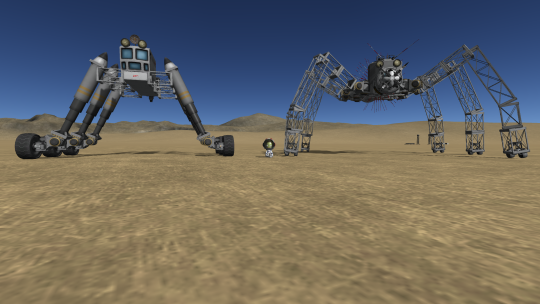
Click here to see the Robotic Parts images in high-res.
The New Suit
This futuristic-looking suit was designed to match the spirit of Breaking Ground. It not only looks great on Kerbals, but offers customization where players can choose what color the helmet and suit lights will glow when in a darkened environment.
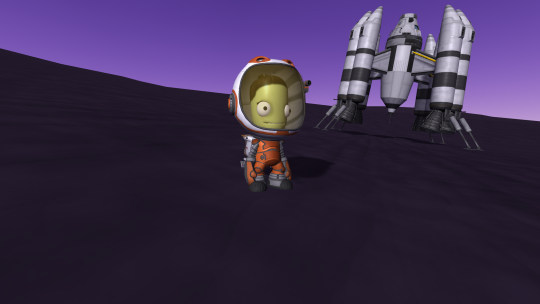
Click here to see the Suits in high-res.
Free Update for Consoles
Coupled with the Breaking Ground Expansion, Kerbal Space Program Enhanced Edition is getting a FREE content-filled console-optimized update that will bring all improvements, features, color variants and part revamps we’ve added up to PC 1.7.3 to console. These updates include:
Altimeter mode toggle
A long-requested quality-of-life feature that will allow you to toggle the altitude mode from Above Sea Level (ASL) to Above Ground Level (AGL) by simply clicking on the new icon to the altimeter. The KSP Team is optimistic that this will lead to improvements in the KSC’s survival rates…

Delta-v per Stage and Delta-v Tool App
Plan missions better and find flaws in your ship staging setup with this long requested feature that will let you visualize the Delta-v values along with a range of other technical data for each stage and the vessel overall. Plus, a Delta-v app that will allow you to get the vessel environment for how Delta-v is calculated in the VAB and SPH. Players will find this very useful!
Improved Burn Time information
The improved burn time indicator will now calculate based on dV and not acceleration. Additionally, it will contain a staging indicator that shows which stages contain the dV needed to complete each part of the maneuver. This will show a red section at the end if there’s not enough dV in the current vessel to complete that maneuver. In the extended mode of the burn time indicator two extra lines are shown, allowing you to adjust how much time you want to spend burning before and after the node during the maneuver as well as showing you a countdown for when you need to start burning fuel to do so.
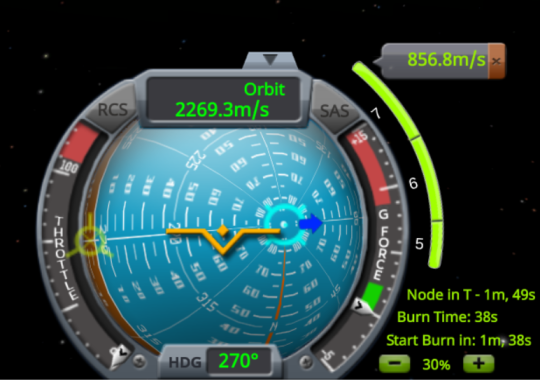
Extensions to the Action Group System
Along with those updates we’re also adding two extensions to our action group system. The first one adds another type of action group for controls that lets you bind input controls to fields - an axis group. The second adds Action Sets, which allow you to enable or disable sets of axes or action groups.
This extends what you can do with a limited number of buttons, allowing you to put your craft into different modes of operation. You can even override the base controls with the action set feature, furthering how you can fine tune the interface between you and your craft. We developed these extensions to give players more options to control their robotics, but it certainly will be useful for stock and modded players as well.
Revamped Parts
A large number of parts have been given a fresh new look since the last update. You’ll be pleasantly surprised to find over 40 new part revamps, including the MK2 Lander Can, which like many other parts, includes a new variant for you to choose at will.
KSP 2 Developer Diary
In case you haven’t read through our latest KSP 2 Developer Diary yet, we invite you to check it out! Included in the post is an early animatic for the concept of our KSP 2 Announce Trailer, which was illustrated and narrated by Star Theory’s Creative Director, Nate Simpson.
To learn more about the effort that went into creating this trailer and how every bump, hiccup and cheer of triumph led to the final KSP 2 Announce Trailer, be sure to read our latest Dev Diary.
Apollo 12 Challenge’s Stellar Stand-outs
Thank you to everyone who participated in the #KSPApollo12 in-game challenge to re-create the Apollo 12 mission. There were so many amazing posts and we wanted to highlight 3 stellar submissions here:
IG: ksp_space_agency
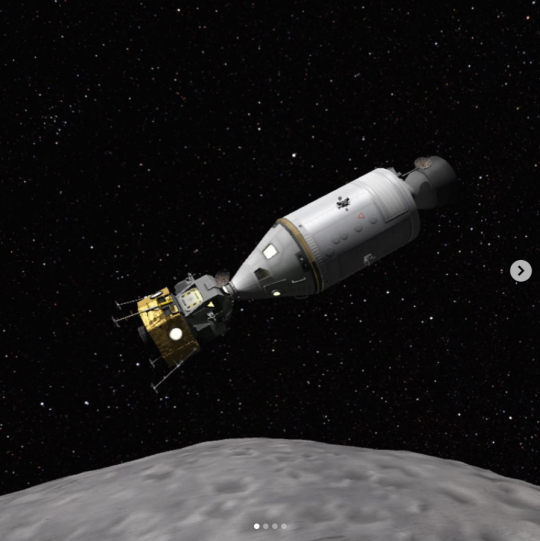
YouTube: Dronez
TWT: Punet Shrivas
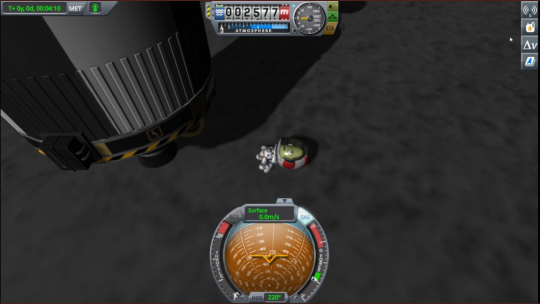
Remember, you can share and download crafts and missions on Curse, KerbalX, the KSP Forum and the KSP Steam Workshop.
That’s it for this edition. Be sure to join us on our official forums, and don’t forget to follow us on Twitter, Instagram and Facebook. Stay tuned for more exciting and upcoming news and development updates!
Happy launchings!
-
Kerbonauts, are you up to the challenge to replicate the Apollo 12 mission in KSP?
If so, what advice would you give those just getting started, so that they're able to successfully replicate the mission in-game?
Be sure to post any in-game video or screenshots of your Apollo 12 style EVA’s, launches, landings or shots of your work in the VAB! We want to share it with the community at large!
In the meantime we have a fun article to share...
Take a look at this amazing article NASA posted today:
nasa:
Launched less than four months after Apollo 11 put the first astronauts on the Moon, Apollo 12 was more than a simple encore. After being struck by lightning on launch – to no lasting damage, fortunately – Apollo 12 headed for a rendezvous with a spacecraft that was already on the Moon. The mission would expand the techniques used to explore the Moon and show the coordination between robotic and human exploration, both of which continue today as we get return to return astronauts to the Moon by 2024.
Launch Day

Apollo 12 lifted off at 11:22 a.m. EST, Nov. 14, 1969, from our Kennedy Space Center. Aboard the Apollo 12 spacecraft were astronauts Charles Conrad Jr., commander; Richard F. Gordon Jr., command module pilot; and Alan L. Bean, lunar module pilot.
Barely 40 seconds after liftoff, lightning struck the spacecraft. Conrad alerted Houston that the crew had lost telemetry and other data from the mission computers. As the Saturn V engines continued to push the capsule to orbit, ground controllers worked out a solution, restarting some electrical systems, and Apollo 12 headed toward the Moon.
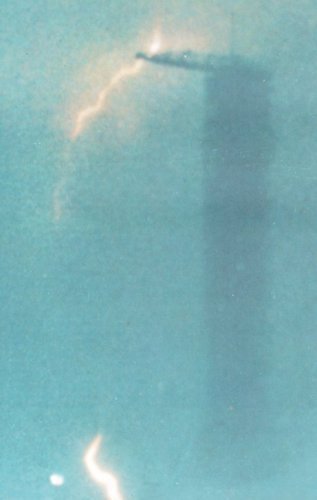
Cameras at the Kennedy Space Center captured this image of the same lightning bolt that struck Apollo 12 striking the mobile platform used for the launch.
On the Moon
Apollo 12 landed on the Moon on Nov. 19, and on the second moonwalk Conrad and Bean walked approximately 200 yards to the Surveyor 3 spacecraft. One of seven Surveyor spacecraft sent to land on the Moon and to gather data on the best way to land humans there, Surveyor 3 had been on the Moon for more than two years, exposed to cosmic radiation and the vacuum of space. Scientists on the ground wanted to recover parts of the spacecraft to see what effects the environment had had on it.
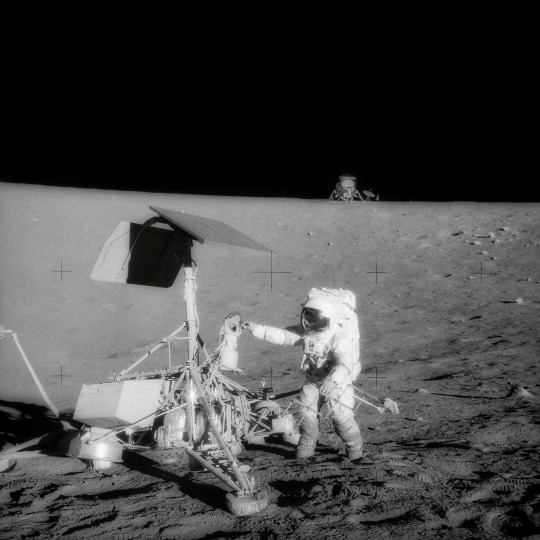
Apollo 12 commander Pete Conrad examines the Surveyor 3 spacecraft before removing its camera and other pieces for return to Earth. In the background is the lunar module that landed Conrad and lunar module pilot Alan Bean on the Moon.
Splashdown
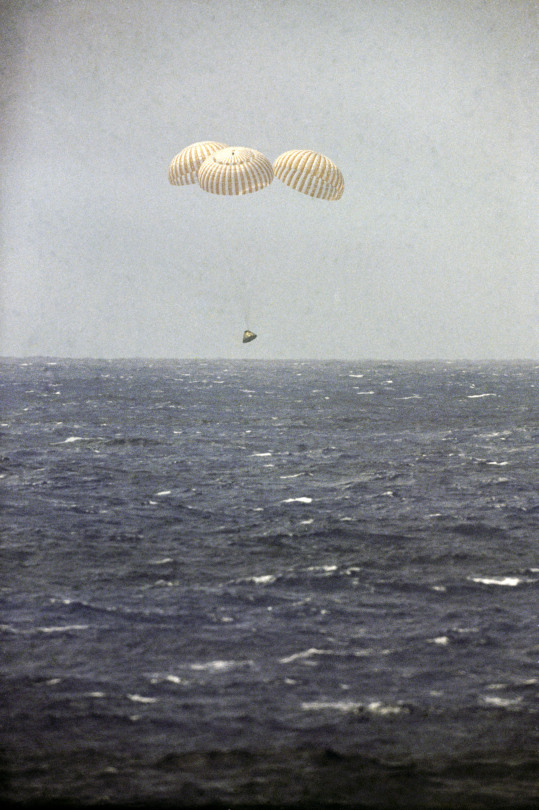
Apollo 12 splashed down on Nov. 24. When Artemis returns astronauts to the Moon in 2024, it will be building on Apollo 12 as much as any of the other missions. Just as Apollo 12 had to maneuver off the standard “free return” trajectory to reach its landing site near Surveyor, Artemis missions will take advantage of the Gateway to visit a variety of lunar locations. The complementary work of Surveyor and Apollo – a robotic mission preparing the way for a crewed mission; that crewed mission going back to the robotic mission to learn more from it – prefigures how Artemis will take advantage of commercial lunar landers and other programs to make lunar exploration sustainable over the long term.
Make sure to follow us on Tumblr for your regular dose of space: http://nasa.tumblr.com.
-
Have you ever wondered what “Set SCE To AUX” means?
Allow Kerbonaut Scott Manley to explain how Apollo 12’s lightning strikes affected the first 2 minutes of flight!
-

In honor of the 50th Anniversary, this week’s #KSPChallenge is to recreate the Apollo 12 Mission.
For those up to the challenge, we wish you a safe launch, landing and lightning strike free journey to the Mun!We’re excited to see you replicate both the launch that took place on Nov 14th as well as EVA’s throughout the mission and the splashdown landing on Nov 24th!
We’ll be sharing and featuring your posts so be sure to tag your in-game footage + screenshots with #KSPApollo12
-
Have you ever wondered what it takes to create an award winning trailer? We’ll show you an early animatic for the concept of our KSP2 Announce Trailer, illustrated and narrated by Star Theory’s Creative Director, Nate Simpson.
To learn more about the effort that went into creating this trailer and how every bump, hiccup and cheer of triumph lead to the final KSP2 Announce Trailer, be sure to read our latest Dev Blog post here: http://bitly.com/KSPdevBlogs
-
nasa:

Since the 19th century, women have been making strides in areas like coding, computing, programming and space travel, despite the challenges they have faced. Sally Ride joined NASA in 1983 and five years later she became the first female American astronaut. Ride’s accomplishments paved the way for the dozens of other women who became astronauts, and the hundreds of thousands more who pursued careers in science and technology. Just last week, we celebrated our very first #AllWomanSpacewalk with astronauts Christina Koch and Jessica Meir.
Here are just a couple of examples of pioneers who brought us to where we are today:
The Conquest of the Sound Barrier
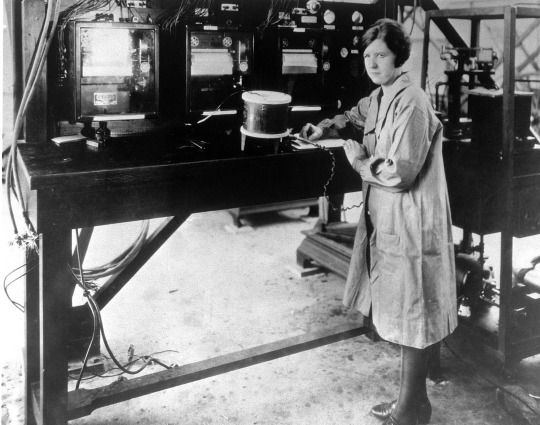
Pearl Young was hired in 1922 by the National Advisory Committee for Aeronautics (NACA), NASA’s predecessor organization, to work at its Langley site in support in instrumentation, as one of the first women hired by the new agency. Women were also involved with the NACA at the Muroc site in California (now Armstrong Flight Research Center) to support flight research on advanced, high-speed aircraft. These women worked on the X-1 project, which became the first airplane to fly faster than the speed of sound.
Young was the first woman hired as a technical employee and the second female physicist working for the federal government.
The Human Computers of Langley
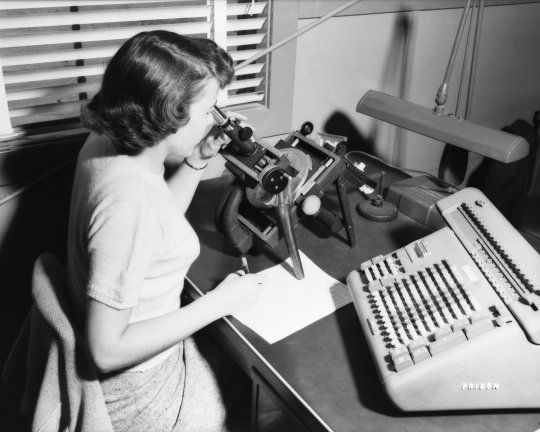
The NACA hired five women in 1935 to form its first “computer pool”, because they were hardworking, “meticulous” and inexpensive. After the United States entered World War II, the NACA began actively recruiting similar types to meet the workload. These women did all the mathematical calculations – by hand – that desktop and mainframe computers do today.
Computers played a role in major projects ranging from World War II aircraft testing to transonic and supersonic flight research and the early space program. Women working as computers at Langley found that the job offered both challenges and opportunities. With limited options for promotion, computers had to prove that women could successfully do the work and then seek out their own opportunities for advancement.
Revolutionizing X-ray Astronomy

Marjorie Townsend was blazing trails from a very young age. She started college at age 15 and became the first woman to earn an engineering degree from the George Washington University when she graduated in 1951. At NASA, she became the first female spacecraft project manager, overseeing the development and 1970 launch of the UHURU satellite. The first satellite dedicated to x-ray astronomy, UHURU detected, surveyed and mapped celestial X-ray sources and gamma-ray emissions.
Women of Apollo
NASA’s mission to land a human on the Moon for the very first time took hundreds of thousands workers. These are some of the stories of the women who made our recent #Apollo50th anniversary possible:

• Margaret Hamilton led a NASA team of software engineers at the Massachusetts Institute of Technology and helped develop the flight software for NASA’s Apollo missions. She also coined the term “software engineering.” Her team’s groundbreaking work was perfect; there were no software glitches or bugs during the crewed Apollo missions.
• JoAnn Morgan was the only woman working in Mission Control when the Apollo 11 mission launched. She later accomplished many NASA “firsts” for women: NASA winner of a Sloan Fellowship, division chief, senior executive at the Kennedy Space Center and director of Safety and Mission Assurance at the agency.
• Judy Sullivan, was the first female engineer in the agency’s Spacecraft Operations organization, was the lead engineer for health and safety for Apollo 11, and the only woman helping Neil Armstrong suit up for flight.Hidden Figures
Author Margot Lee Shetterly’s book – and subsequent movie – Hidden Figures, highlighted African-American women who provided instrumental support to the Apollo program, all behind the scenes.

• An alumna of the Langley computing pool, Mary Jackson was hired as the agency’s first African-American female engineer in 1958. She specialized in boundary layer effects on aerospace vehicles at supersonic speeds.
• An extraordinarily gifted student, Katherine Johnson skipped several grades and attended high school at age 13 on the campus of a historically black college. Johnson calculated trajectories, launch windows and emergency backup return paths for many flights, including Apollo 11.
• Christine Darden served as a “computress” for eight years until she approached her supervisor to ask why men, with the same educational background as her (a master of science in applied mathematics), were being hired as engineers. Impressed by her skills, her supervisor transferred her to the engineering section, where she was one of few female aerospace engineers at NASA Langley during that time.Lovelace’s Woman in Space Program
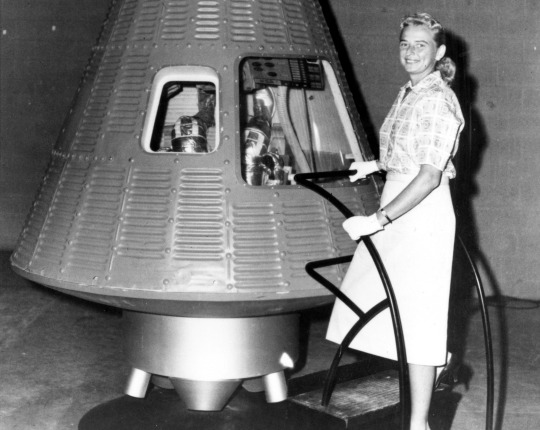
Geraldyn “Jerrie” Cobb was the among dozens of women recruited in 1960 by Dr. William Randolph “Randy” Lovelace II to undergo the same physical testing regimen used to help select NASA’s first astronauts as part of his privately funded Woman in Space Program.
Ultimately, thirteen women passed the same physical examinations that the Lovelace Foundation had developed for NASA’s astronaut selection process. They were: Jerrie Cobb, Myrtle “K” Cagle, Jan Dietrich, Marion Dietrich, Wally Funk, Jean Hixson, Irene Leverton, Sarah Gorelick, Jane B. Hart, Rhea Hurrle, Jerri Sloan, Gene Nora Stumbough, and Bernice Trimble Steadman. Though they were never officially affiliated with NASA, the media gave these women the unofficial nicknames “Fellow Lady Astronaut Trainees” and the “Mercury Thirteen.”
The First Woman on the Moon
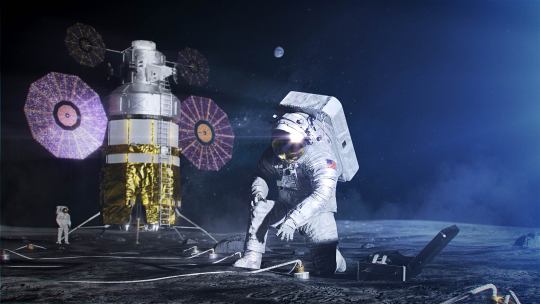
The early space program inspired a generation of scientists and engineers. Now, as we embark on our Artemis program to return humanity to the lunar surface by 2024, we have the opportunity to inspire a whole new generation. The prospect of sending the first woman to the Moon is an opportunity to influence the next age of women explorers and achievers.
This material was adapted from a paper written by Shanessa Jackson (Stellar Solutions, Inc.), Dr. Patricia Knezek (NASA), Mrs. Denise Silimon-Hill (Stellar Solutions), and Ms. Alexandra Cross (Stellar Solutions) and submitted to the 2019 International Astronautical Congress (IAC). For more information about IAC and how you can get involved, click here.
Make sure to follow us on Tumblr for your regular dose of space: http://nasa.tumblr.com
-

Welcome to our official newsletter, KSP Loading…! If you want to learn about all the current developments of the KSP franchise, then this is the place to be!
A new DLC and a Free Update for Kerbal Space Program Enhanced Edition is on its way
We have some big news for console players! The team is currently working on a new DLC for KSP Enhanced Edition! Based on the PC release of the Breaking Ground Expansion, this downloadable content will be all about exploration, experimentation, and technological breakthroughs. So put on your helmets and prepare to explore the vastness of the Kerbolar system from the comfort of your couch.
Coupled with the DLC, a free and content-filled update will be released for KSP Enhanced Edition. This update will include several of the features that we have developed over the past year. We will reveal more information about the features and the exact release date in the upcoming weeks, so stay tuned!
Kerbal Space Program Update 1.8 on PC
The KSP team is so excited about the features being worked on for Update 1.8. With this update we continue making KSP more stable and performant while adding quality of life features to improve the player experience. In addition to what you have already learned in our previous installment, we have some other neat content coming to this update.
Terrain Revamp for Eve and Gilly
Eve and Gilly are two more celestial bodies which are getting a make-over with new high-quality texture maps & graphic shaders. Together with Duna, Ike, Minmus and Mun, the celestial bodies will be worth revisiting, if only for the view.
Eve
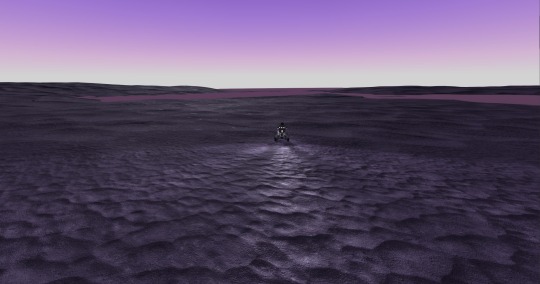
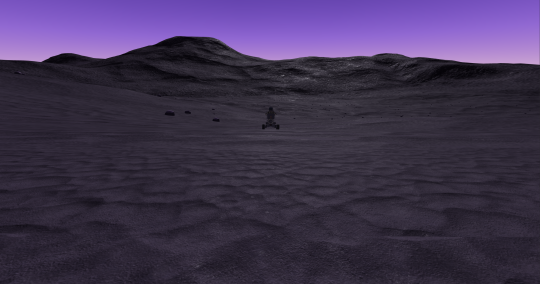

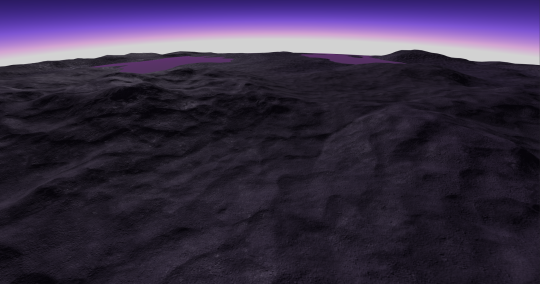
Gilly
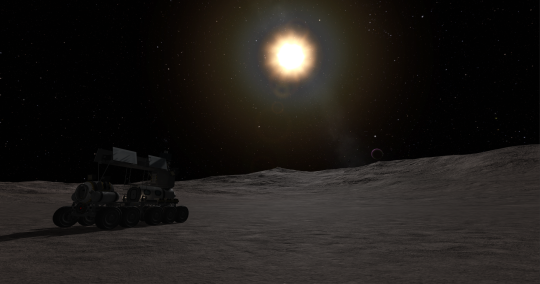
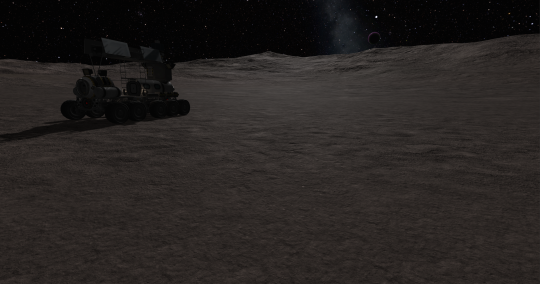
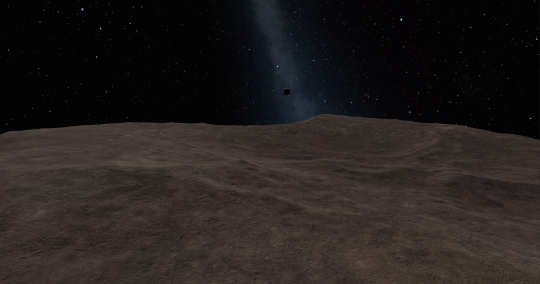

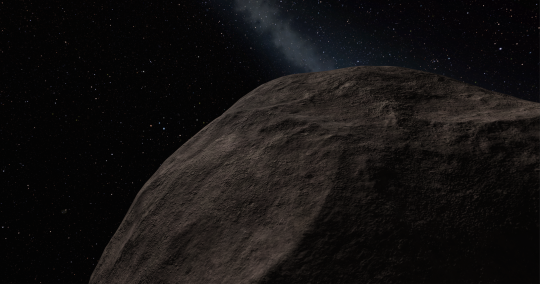
Ike

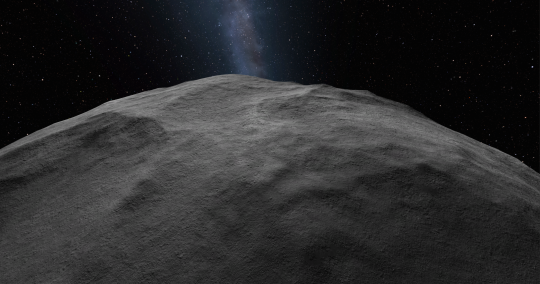

Minmus
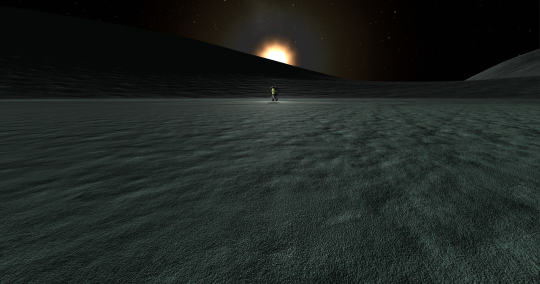

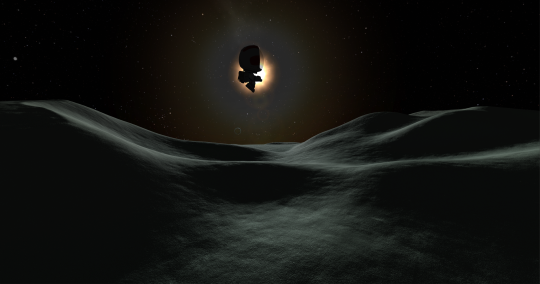
Click here for high-res images.
KSC Texture Improvements
At the Kerbal Space Center, we have reduced the grass repetition, improved blending between grass and concrete and tweaked some level 1 and 2 buildings with some new textures and improved shaders. All in all, the KSC will look better than ever after this update.
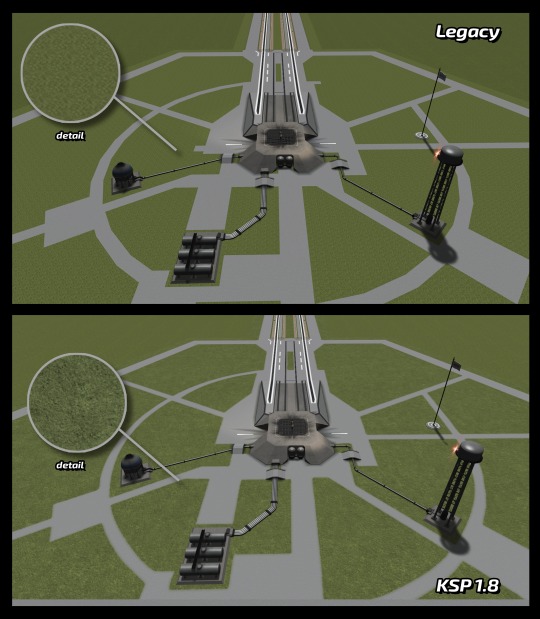
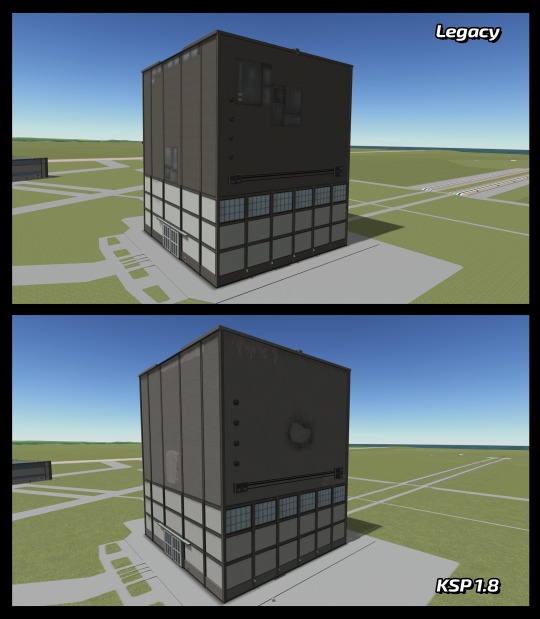
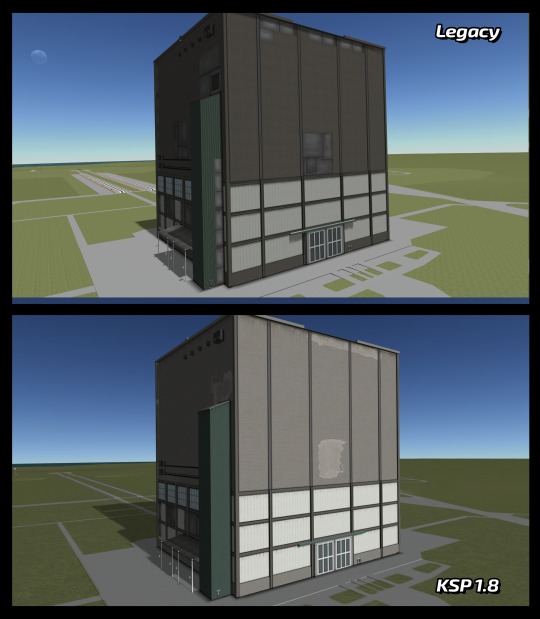
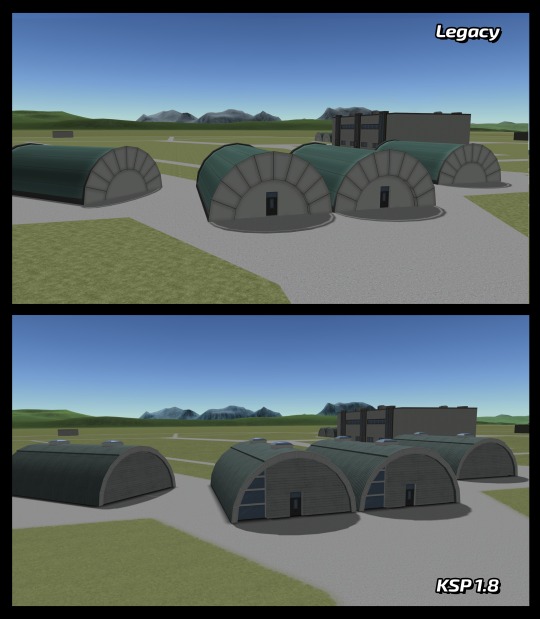
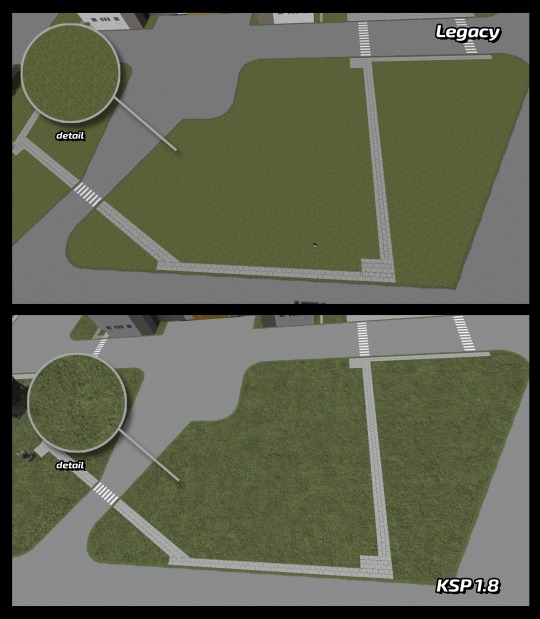
Click here to see the high-res images.
Map Mode Changes
Some adjustments are being made to the game’s Map Mode. With this update you will be able to use docking mode and stage your craft whilst in map mode. The stage display button (formerly stage mode) now serves as a toggle to show & hide the stage stack, whether you’re in flight or map view and the map labels will now persist when going back and forth between map and flight mode.
New SRBs
If you’ve been following us, you’ll already know that we’re bringing a range of new solid rocket boosters to the game. From the tiny .625m stack size Mite to the titanic 2.5m wide, 144ton Clydesdale, these new boosters will offer a range of versatile solid-fuel options. Making History owners get an extra bonus here too with the “Pollux” and a 1.875m nosecone to fit on top of it.
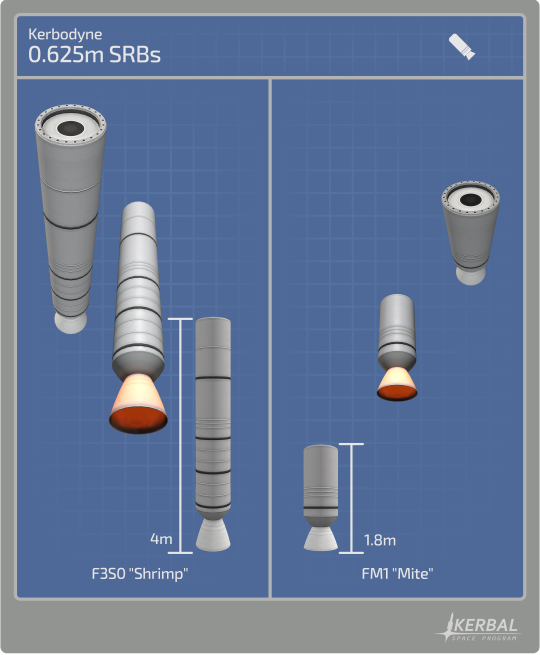
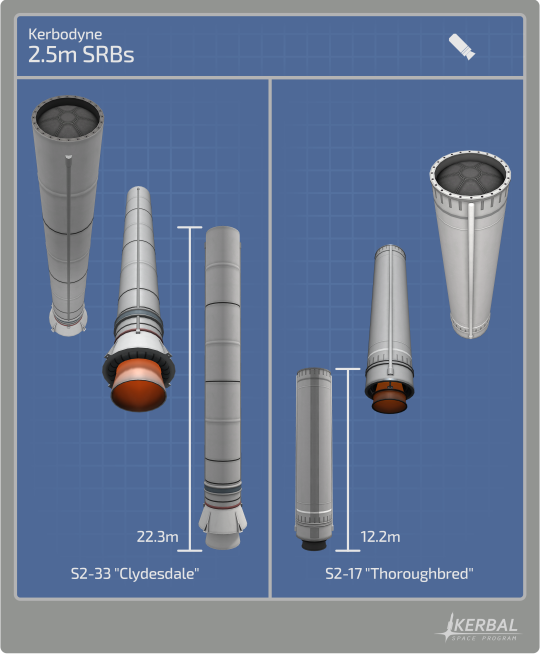

Click here to see high-res images.
Warp to Next Maneuver in NavBall
We are also including a small quality of life feature to the NavBall suggested in the public tracker by 5thHorseman. A warp to next maneuver button is being added to have this option on hand whenever players need it.
Kerbal Space Program 2 at PAX West
We’d like to say thank you again to everyone who visited our Kerbal Space Program booth at PAX West! We are forever grateful for the continued support for Kerbal Space Program 2. Over 2,000 Kerbonauts visited our booth to take photos with Jeb on the Mun, watch our “behind closed doors” presentation with exclusive details sharing gameplay footage of KSP2, and all attendees received their very own KSP flag!
During PAX West we also had the chance to hold our very first KSP Community Event with content creators like Scott Manley, Das Valdez, EJ_SA, Shadowzone, Bad News Baron, and Billy Winn Jr. Also attending the event were leaders within the KSP Forum and Modders; Snark, Galileo and LinuxGuruGamer.
These pivotal community members had the opportunity to meet with Star Theory and pose questions regarding KSP2 directly to the developers. Many of these content creators have since shared their thoughts on this momentous experience across their respective channels and we encourage you all to give them a watch! Thank you all so much, it’s because of your avid support and interest in the game that we have officially grown into a franchise.
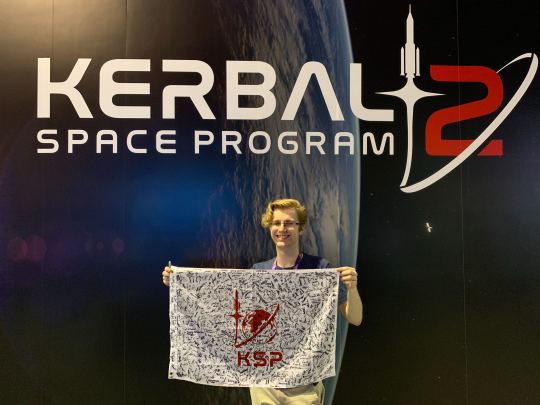
Matt, Star Theory developer who got signatures from fans at PAX West who visited our booth.
Take a look at our PAX West booth in our Instagram story videos!
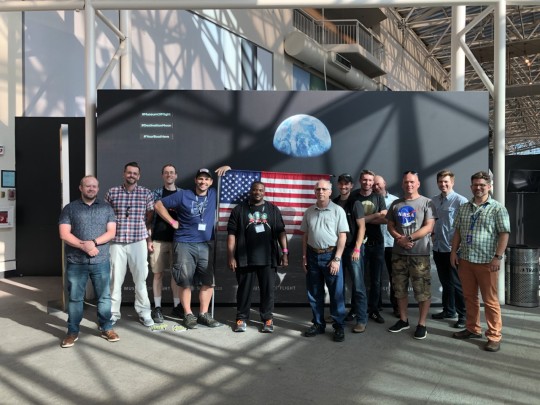
(L to R: Galileo, Shadowzone, Snark, EJ_SA, Jatwaa, LGG, Das, Nate Simpson (Creative Dir. Star Theory), Scott Manley, Chuck Noble (Principal Engineer at Star Theory), BadNewsBaron, Geoff (Museum of Flight).
Scott Manley at PAXW
ShadowZone at PAXW
Loading Screen Contest
We also want to remind you that you still have until next week (October 2nd) to participate in our Loading Screen Contest! So submit your illustrations, screenshots, pictures and/or any form of fanart you’d like to see in KSP’s in-game loading screens! We will select a set of finalists and their art will be included in update 1.8.
Remember, you can share and download crafts and missions on Curse, KerbalX, the KSP Forum and the KSP Steam Workshop.
That’s it for this edition. Be sure to join us on our official forums, and don’t forget to follow us on Twitter, Instagram and Facebook. Stay tuned for more exciting and upcoming news and development updates!
You can also follow Squad and Star Theory on the main social media platforms:
https://www.facebook.com/startheorygames/
https://twitter.com/startheorygames
-

Welcome to our official newsletter, KSP Loading…! If you want to learn about all the current developments of the KSP franchise, then this is the place to be!
Kerbal Space Program 2
Last week at the opening night of Gamescom we announced the forthcoming sequel and newest addition to our franchise, Kerbal Space Program 2! This sequel will be expanding upon what makes Kerbal Space Program great and will bring space exploration to the next generation with exciting new features that will delight veteran and new players alike.
We’re excited to introduce you to Star Theory Games, the developer studio behind Kerbal Space Program 2!
Learn about the new development team joining the franchise by watching the Developer Story Trailer. Watch our Cinematic Trailer below to see what we’ll be bringing to KSP2!
So what can you expect in 2020, when Kerbal Space Program 2 comes out of the VAB? These are just some of the features, you’ll be able to enjoy:
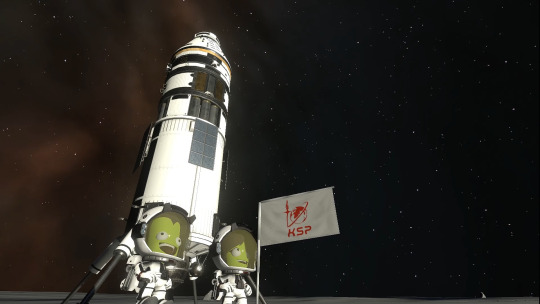
Improved Onboarding
Rocket science can be a bit overwhelming sometimes and one of the things that Star Theory has set their minds towards is helping facilitate newcomers on their journey to become space explorers. With new animated tutorials, improved UI, and fully revamped assembly and flight instructions, it will be easier than ever to put your creativity to the test, all without sacrificing any of the challenge from the original game.
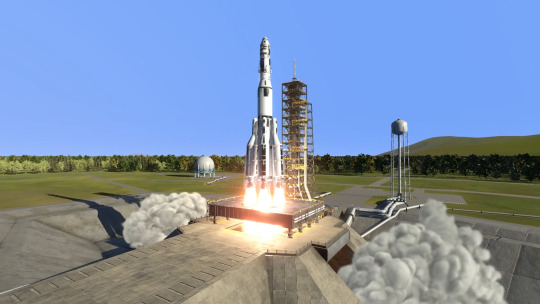
Next Generation Technology
Kerbal technology is taking major steps forward in Kerbal Space Program 2. With next-generation engines, parts, fuel, and much more, prepare to venture farther within and beyond the original star system!

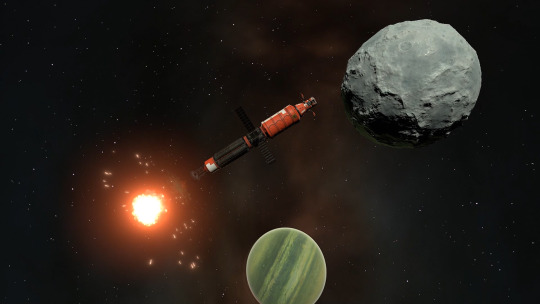
Colonies
Long term colonization of celestial bodies has become a priority for Kerbalkind. Gather resources to construct buildings, space stations, and habitations, as well as find and process unique fuel types. Eventually, these colonies become advanced enough for vehicle construction, propelling them towards deep space and beyond. It’s time for Kerbals to become a type 2 civilization!
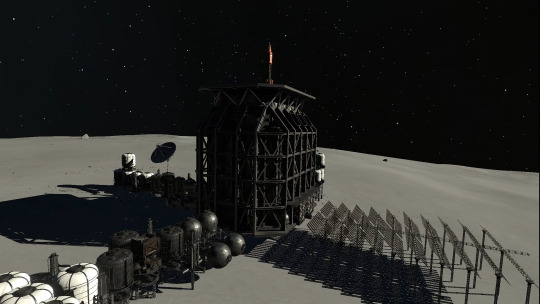
Interstellar Travel
With their next-gen tech, colonies, and resource gathering, Kerbals will reach new levels of exploration: interstellar travel. That’s right, in Kerbal Space Program 2, you’ll be able to discover extrasolar systems with whole new celestial bodies to explore. Among them: Charr, a heat-blasted world of iron; Ovin, a ringed super-Earth with relentless gravity; Rask and Rusk, a binary pair locked in a dance of death; and many more to reward exploration. What mysteries await in these alien worlds? It will be up to you to find out!
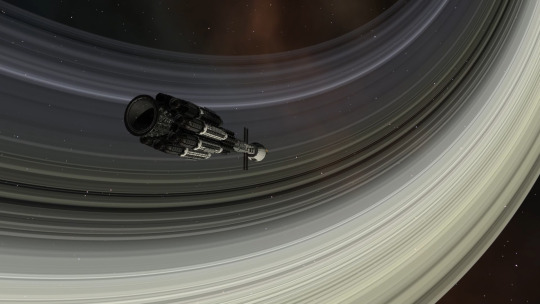
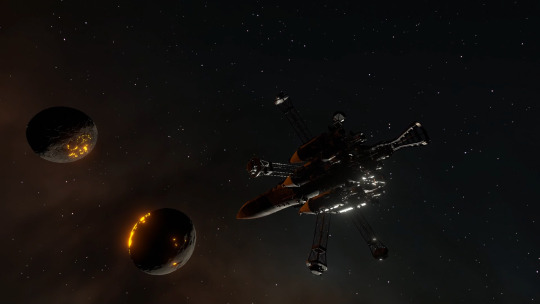
Multiplayer/Modding
Modding has always been an essential part of KSP and with Kerbal Space Program 2 it will continue to be so. The technological developments made to the foundations of Kerbal Space Program 2 will build on the beloved modding capabilities of the original game, as well as deliver on the long-requested addition of multiplayer. Soon players will be able to share the challenges of deep space exploration. We’ll reveal more details on these and more features at a later time, so stay tuned!
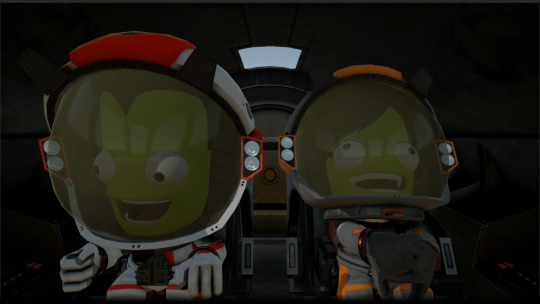
Click here to see these and more screenshots in high-res.
PAX West 2019
Want to see the behind-closed-doors presentation of KSP 2 gameplay? Come by booth 1909 during normal show hours to chat with the developers, take a photo with the Jeb statue, see the presentation, and grab a PAX West exclusive KSP Flag! If you take a photo there be sure to tag @KerbalSpaceP and use #BuildFlyDream.
Kerbal Space Program Update 1.8
We are all very excited for what’s coming in 2020, but until then, there is still plenty of KSP for everyone to enjoy! Squad will continue to support the current game, and as some of you may have seen, there is some really cool stuff coming in the next update for the game Click here to read Squad’s statement in regard to the KSP 2 announcement.
Squad’s goal will always be to provide the best experience for all KSP players. The gameplay experience will be improved even further for KSP 1 with the 1.8 update. Here are some more details of what you can look forward to in this latest update.
Celestial Body Visual Improvements
If you’ve been following KSP on social media, you might have already learned that new high-quality texture maps & graphic shaders are being implemented for various celestial bodies. In update 1.8 you’ll find high quality texture maps for Mun, Duna and a few other Celestial Bodies that will be revealed along the way.
If there are any concerns that the update might hinder the game’s performance on your computers, rest easy knowing you’ll be able to select the celestial bodies’ shader quality in the settings to low (legacy), medium or high. Even for the legacy option, you can expect texture stretching errors to be vastly improved. With the high-quality option, pixel density will be maintained regardless of camera distance to the celestial body, as well as a lack of tiling problems. All in all, celestial bodies will look sharper and more realistic. Take a look for yourself:
Unity Upgrade
Update 1.8 brings an improvement that Squad has wanted to introduce for some time now - an upgrade to the underlying engine of the game to Unity 2019.2
With this upgrade there are some long-desired performance and graphic improvements, some of which come out of the box, and some which will allow further enhancements down the road.
These include:
- KSP will now run under DX11 on the Windows platform (DX9 will no longer be supported) which allows many graphical improvements, such as those on the planetary textures.
- A new PhysX version with the associated performance and precision improvements.
- GPU instancing to improve rendering performance.
- Incremental garbage collection to reduce frame rate stutters, particularly in modded installs.
And many others.
While this version will have a larger impact on many mods, more than 1.6 or 1.7, the process has been tested and is relatively fast. Still, there will be several changes, due to the introduction of the Roslyn compiler, which brings full C#7 support and moving to full .NET 4.x API (.NET 3.5 support is deprecated). There will be continued efforts to reduce significant impact for Modders, but the belief is this time around the benefits of this upgrade far outweigh the drawbacks.
New Parts for Breaking Ground
Update 1.8 will also include some exclusive treats for owners of the Breaking Ground Expansion. A new set of fan blades and shrouds will continue to push the creativity of KSP players even further. By combining these fan blades with small electrical rotors and the new shrouds, you’ll be able to increase the performance and thrust of your propellers. Use them to create drones, ducted fan jets, or anything you can imagine.
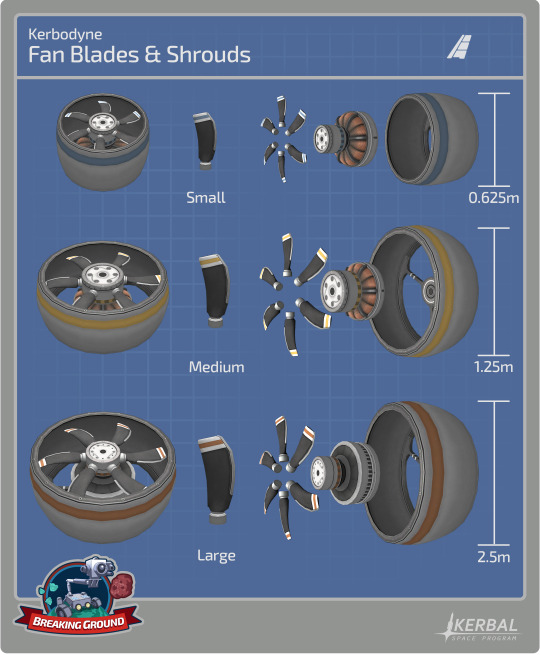
Improvements are also being made to robotic part resource consumption, with better info on consumption and new improved options for power-out situations.
Remember, you can share and download crafts and missions on Curse, KerbalX, the KSP Forum and the KSP Steam Workshop.
That’s it for this edition. Be sure to join us on our official forums, and don’t forget to follow us on Twitter, Instagram and Facebook. Stay tuned for more exciting and upcoming news and development updates!
Happy launchings!
-

ResearchBodies is a really cool Mod that makes Career mode even more realistic by making Celestial Bodies invisible at the start of a new game. Scan the skies and discover planets with a telescope, research them meticulously, and accept new contracts to gather science to advance your space program and unlock the Observatory Facility. Cool, right?
Click here to learn more and get ResearchBodies
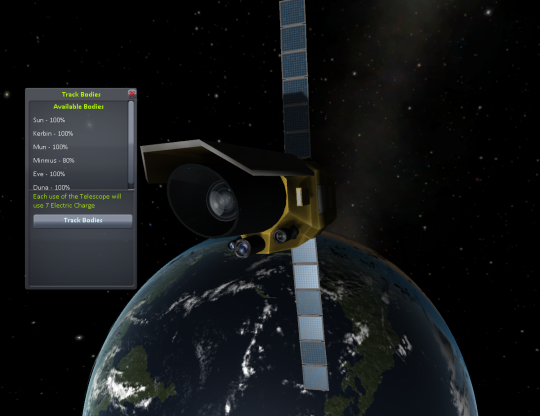
-

Watch how Cupcake Landers explores the surface of Duna using some unconventional means of transportation… -

Scott Manley shares his thoughts on KSP’s new DLC, Breaking Ground, and builds a few interesting crafts, including his interpretation of Virgin Galactic’s Spaceship II.
-

Welcome to our official newsletter, KSP Loading…! Do you want to learn about all the current developments of KSP? Here’s the place to be, so let’s get started!
Breaking Ground Expansion
With the release of the Kerbal Space Program: Breaking Ground Expansion just around the corner, our team is working very hard to wrap up the final details for this exciting DLC. We also thought this would be a good opportunity to dive into a little bit more depth and give you a better idea of what you can expect in Breaking Ground.
As we mentioned previously, this DLC is all about exploration, experimentation and technological breakthroughs. We want to give you more reasons to explore Kerbin’s solar system, more things to do while you’re on a celestial body and exciting new robotics parts that add a whole new level of complexity allowing you to build even more incredible crafts.
Deployed Science
This feature will allow you to deploy experiments on the surface of celestial bodies to take measurements over time. You will need to bring these experiments with you, unpack them from storage containers on your craft and set them up to run. In order to do so you will need to place a central station, one or more power generating devices and possibly a booster antenna to get your science base set up. The experiments and power generators will run better if the right kind of Kerbal sets them up, thus giving you more reasons to bring Kerbals with different professions on an adventure.
We wanted to broaden the possibilities for future development, adding a time-based mechanic with deployed science, which also introduces inventory into stock KSP.
- Paul Boyle, Lead DesignerLet’s look at the equipment available for Deployed Science:
Probodobodyne Experiment Control Station
This part is crucial if you want to generate any useful data. Acting as the hub for all other experiments, the Experiment Control Station will distribute and control both power and data from nearby deployed parts, as well as coordinate the transmission of science back to Kerbin.
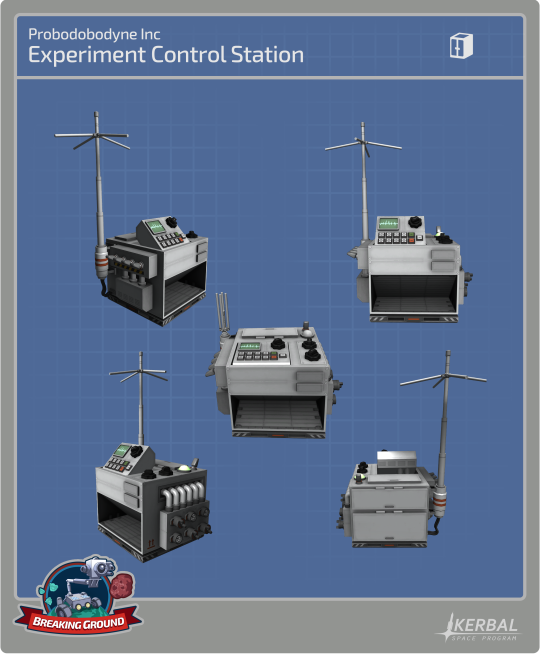
Mini-NUK-PD Radioisotope Thermoelectric Generator
No science base will run without power, and the Mini-NUK-PD Radioisotope Thermoelectric Generator will provide plenty of power to run a central station and deployed science experiments. If deployed by an engineer it will more efficient, if they are a high level one then even more.
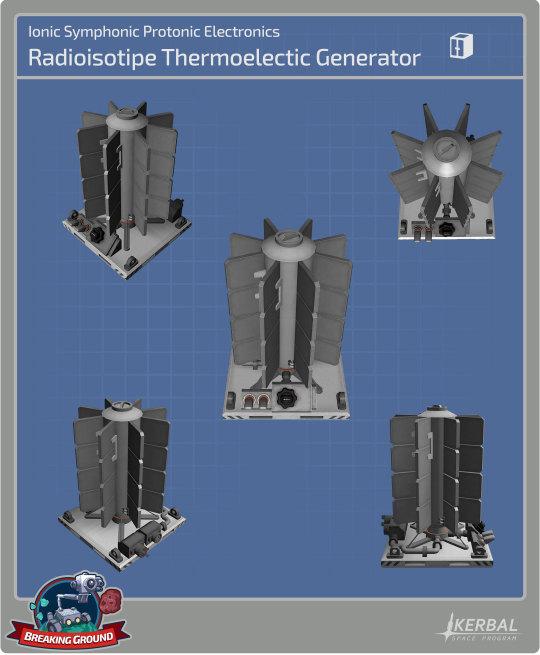
OX-Stat-PD Photovoltaic Panel
An alternative power generator is the OX-Stat-PD Photovoltaic Panel, which will also be more efficient when properly set up by a trained engineer.
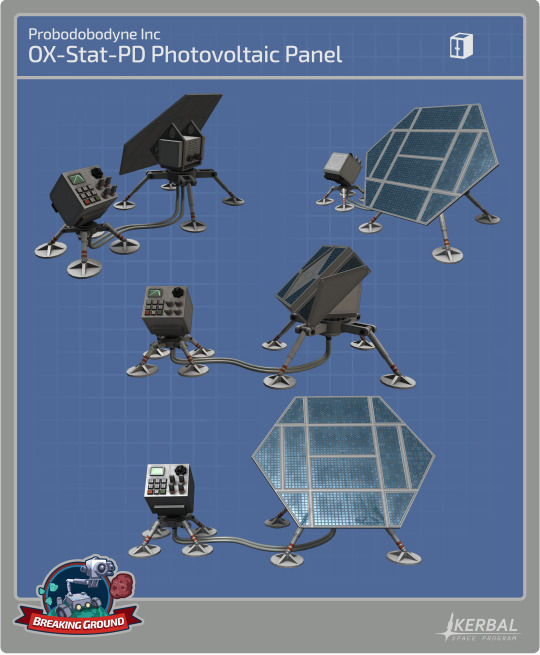
Communotron Ground HG-48
Although the Experiment Control Station has its own data transmission device, if you’re on a faraway planet, you might need to bring the Communotron Ground HG-48 antenna with you to boost the signal of your deployed science base.

Go-ob ED Monitor
The Goo Observation: Extended Duration Monitor watches the always enigmatic Mystery Goo for a long period of time on a planetary body. As with all the other deployed science experiments, the data collection speed will be increased when placed by a scientist, especially a ranked-up scientist.
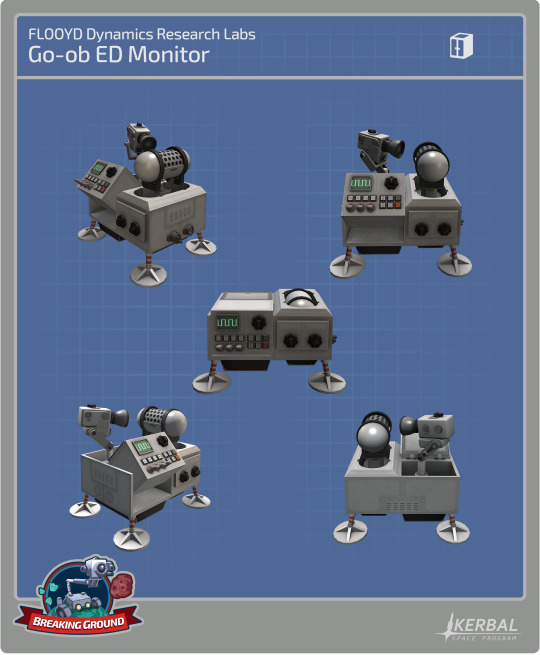
PD-3 Weather Analyzer
This multi-function experiment gathers data on wind, pressure, temperature and humidity to generate a picture of the planet’s climate model over time. Naturally it will only function on a planet with an atmosphere.
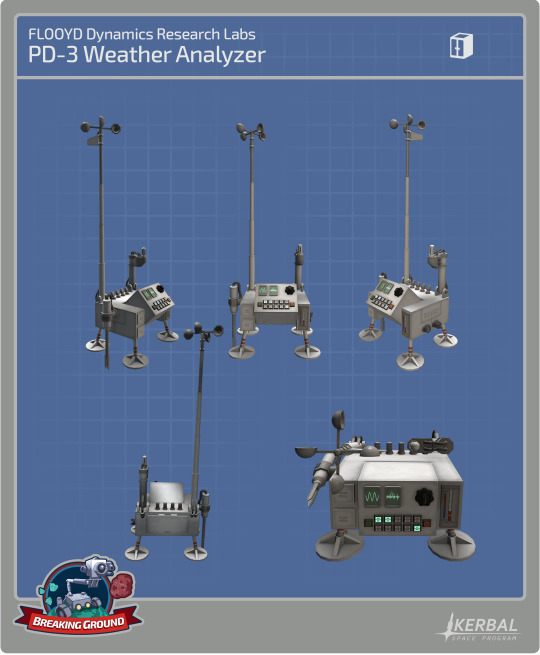
Ionographer PD-22
This experiment allows Kerbals to analyze different particles and radiation incident on planetary bodies with no atmosphere.
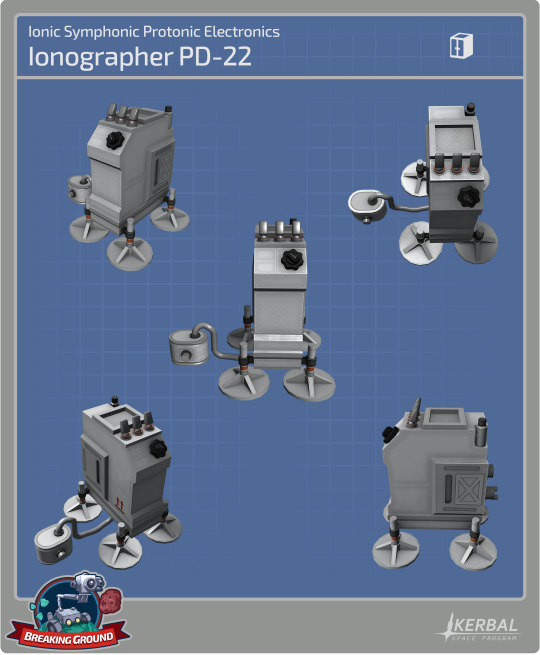
Grand Slam Passive Seismometer
Unlike other experiments, the Grand Slam Passive Seismometer only operates under one condition… when controlled seismic events are created by crashing something into a planet. In addition to the excitement and fun of smashing things, you’ll collect data instantaneously with this device.

Click here to see all images of the Deployed Science experiments in high-res.
Surface Features
Surface features add a new component to the exploration of planets and satellites in the KSP solar system. These are items of scientific interest scattered across all celestial bodies. These features include meteorites, craters, mineral formations, and even stranger planetary oddities. Surface features vary in size and Kerbal astronauts will be able to pick up and return the smallest of them for study back at KSC. However, larger ones will need to be scanned and analyzed on-site by the newly developed Rover Arms.
Exploring celestial bodies and using rovers has never had as much value as we would have liked, and while the real Opportunity is now quietly resting on Mars, we wanted to give the players the opportunity to do more valuable science driving across Duna (and the other bodies) in KSP. So we added interesting new features to the surface of the planets that can be explored and have experiments performed on them.
- Jamie Leighton, Lead Developer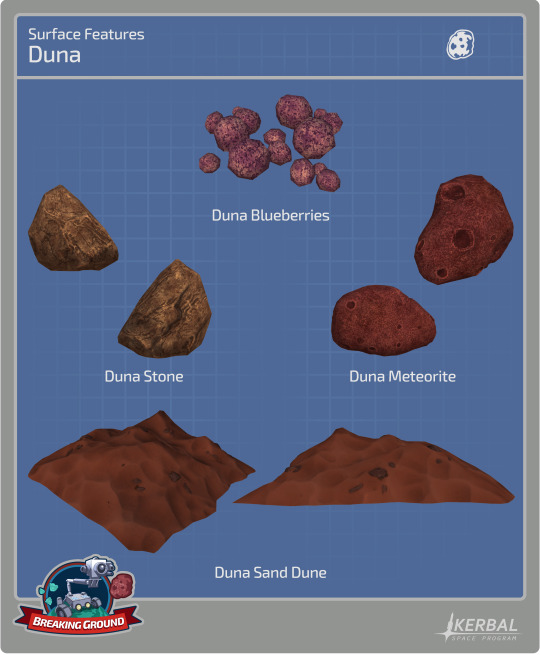
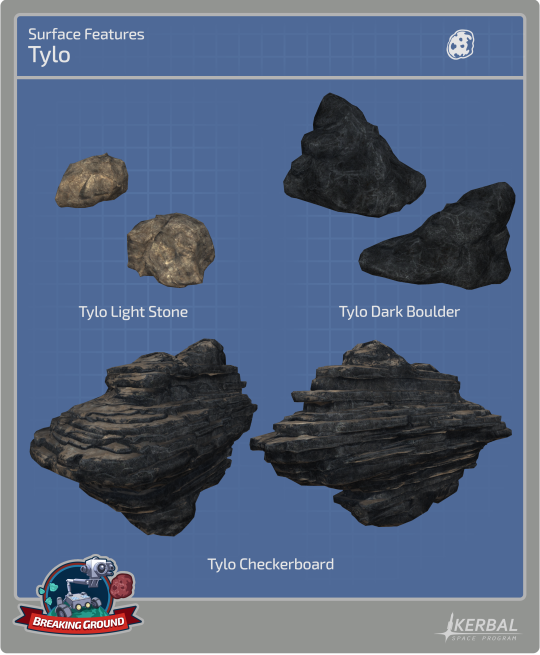

Rover Arms
These parts are used to gather scientific data from surface features. The Rover Arms come in three levels that you unlock via Research and Development, each of which has more sensors and tools that allow you to collect more science from the same surface feature. Only the largest Rover Arm has the full suite of scientific instruments, so you might want to unlock that one as soon as possible!
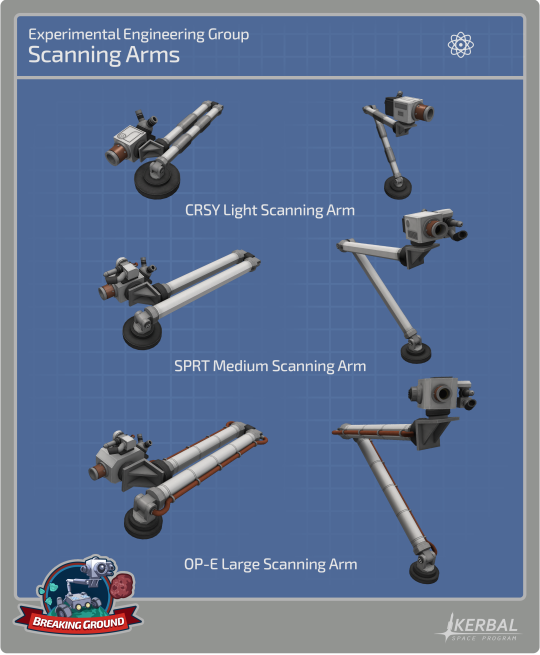
Click here to see all these and a couple more images of Surface Features and the Rover Arm in high-res.
Robotics
With Breaking Ground, you will see four types of robotic parts - hinges, pistons, rotors and rotational servos. Available in a range of shapes and sizes these new parts operate under realistic physics, with real forces and torques, electricity consumption and even motor mass accounted for. We are also including a controller part that will let you coordinate the behavior of many different parts on your craft.
Giving our community the ability to build even more complex creations might seem like a strange idea for anyone familiar with KSP, but it is something the whole team is passionate about. I’m really looking forward to seeing what people can make and animate with the new parts and controller combination.
- David Tregoning, Lead DeveloperHinges
Hinges will give you a limited angle of rotation between two parts. Perfect to create jointed machines for example.

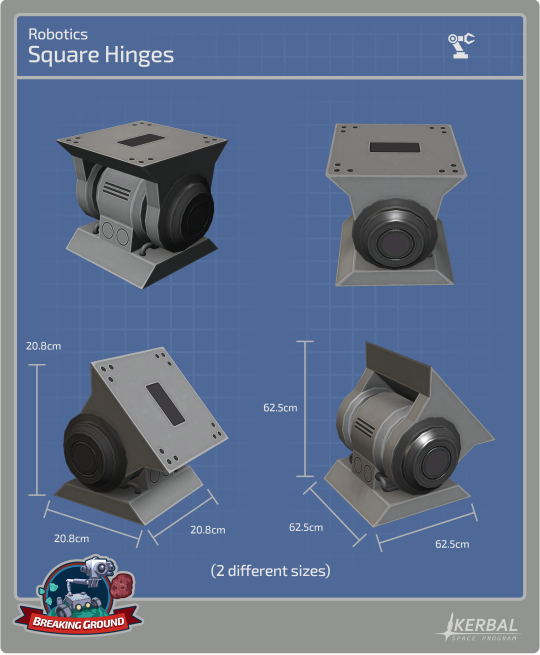
Piston
The pistons give you linear motion. If set up right, they will allow you to create all sorts of craft with hydraulic-like mechanisms.
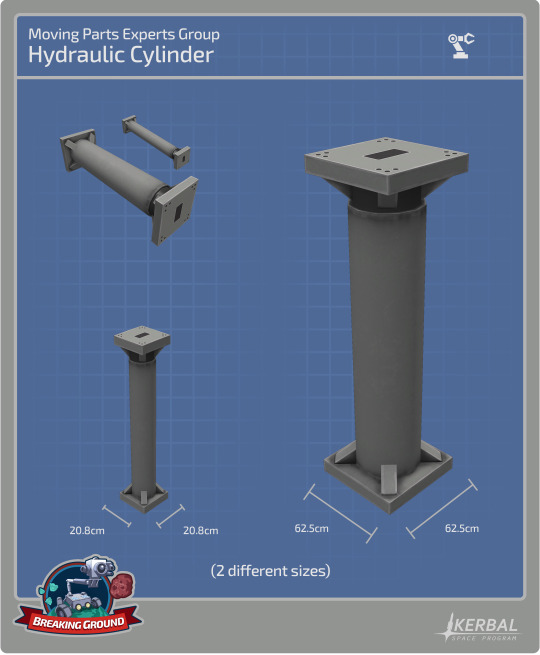
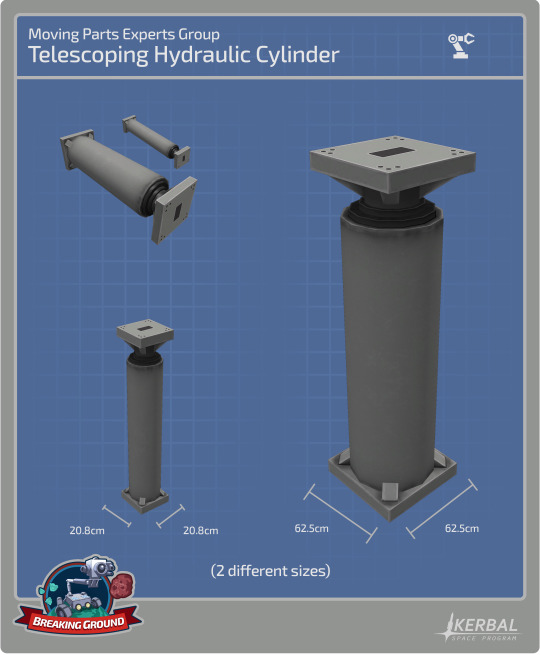
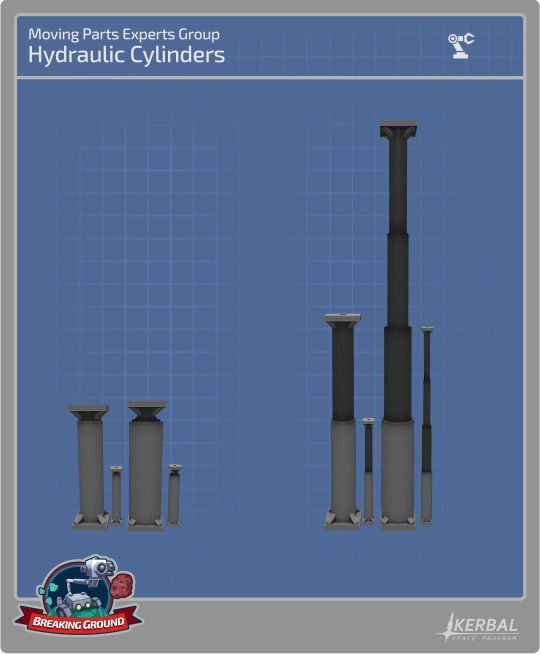
Rotor
Not much to explain about the rotor, it will allow you to generate torque around its axis. Maybe you’ll build a spinning space station or ferris wheel with this, or any other rotational contraption you can think of.
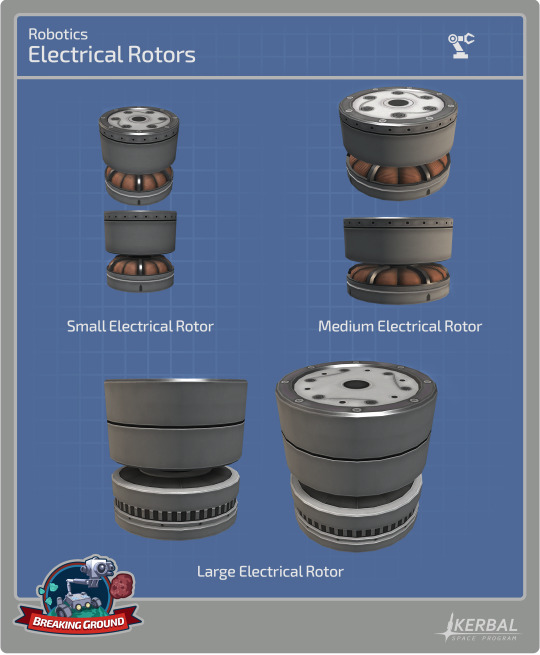
Rotational servo
The Rotational servo will give you precise control of angular position. Using proportional control, servos have unlimited potential to create all sorts of inventions, where you want to have precise control of the position of certain parts.
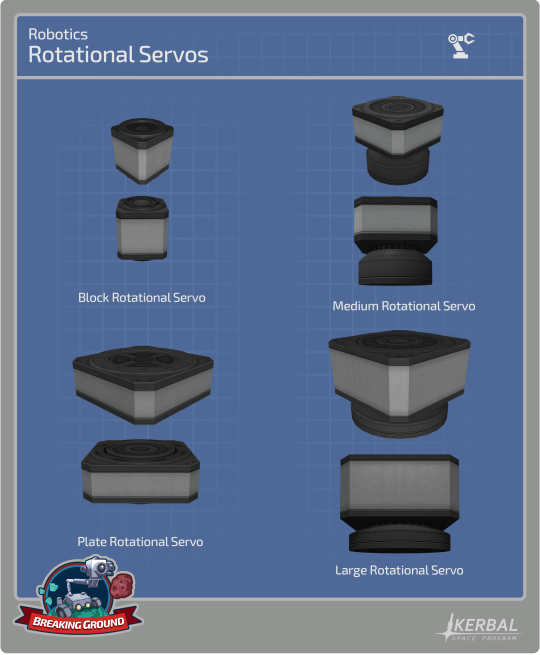
KAL Controller
The KAL-1000 controller can sequence the actions of all the robotics parts, and a number of other fields. Its gives you access to a powerful track editor tool to let you set up how parts will behave over time. Using the controller, you can set up complex cranes, walking craft, disco lighting or whatever your heart desires.
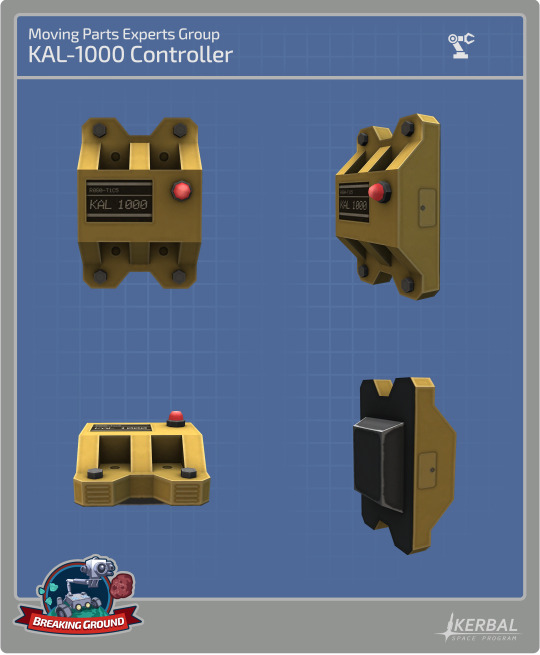
Click here to see the Robotic Parts images in high-res.
The New Suit
This futuristic-looking suit was designed to match the spirit of Breaking Ground. It not only looks great on Kerbals, but its seams glow in the dark when you turn on the helmet lights!

For the spacesuit we tried a few options based on existing concepts from real life space programs, but some of those looked too slim or too sci-fi-ish. We also tried different helmets, but something felt weird about the shapes, and as the Kerbal helmet is iconic, we kept the classic shape when designing a new one. Apart from the design, we wanted to give the suit something that the others don’t have: An emissive light at the seams, something that comes in handy to help find your Kerbals when they are far from the sun or on the dark side of a planet! At first, we thought skinning the accordion arms would be problematic, but we managed to do it, and we are pretty happy with the result. We hope you like it as much as we do!
- Rafael Gonzalez, Lead ArtistClick here to see the Suits in high-res.
Additions to the base game
With the release of Breaking Ground, the base game is also getting some updates that will add a few new features.
For starters, the inventory mechanic that is used by deployed science will be available in the base code, for modders to use and extend as they wish.
Additionally, we’re adding two extensions to our action group system. The first one adds another type of action group for controls that let you bind input controls to fields - an axis group. The second adds Action Sets, which allow you to enable or disable sets of axis or action groups.
This extends what you can do with a limited number of keys, letting you put your craft into different modes of operation. You can even override the base controls with the action set feature, further fine tuning the interface between you and your craft. We developed these extensions to give players more options to control their robotics, but it certainly will be useful for stock and modded players as well.
Finally, we’ve added EVA portraits, so that you can check data on your Kerbals even when they’re out and about.
Remember, you can share and download crafts and missions on Curse, KerbalX, the KSP Forum and the KSP Steam Workshop.
That’s it for this edition. Be sure to join us on our official forums, and don’t forget to follow us on Twitter, Instagram and Facebook. Stay tuned for more exciting and upcoming news and development updates!
Happy launchings!
-

Matt Lowne’s Blunderbirds take on a mission to rescue Jeb from the depths of the Tylo Cave - after completing his mission to film some scenes for the “Expedition Eve” and “Green Harvest” movies!
-

Scott Manley takes a look into KSP 1.7: Room to Maneuver and goes on an epic mission to visit all planets in the Kerbin System through a series of gravity assist maneuvers. Nice! -

Billy Winn Jr aka. Jatwaa buids and tests a Kerbal replica of Clément Ader’s early steam-powered aircraft, Éole, originally developed in 1890s. Check it out!
-

Marcus House and ShadowZone team up in this video to determine which rocket could replace SLS for Orion Exploraion Mission 1 (EM-1): SpaceX Falcon Heavy or Delta IV Heavy from ULA. Check it out!
-
Kerbal Space Program 1.7: Room to Maneuver releases next week! Check out this new feature that will transform the way you perform planetary transfers.
-

Tom Kleingarn takes 29 individual rovers chained together for ride. Behold the almighty centipede rover!
-

KSP Interstellar Extended (KSPIE) is a plugin for Kerbal Space Program that gives players access to contemporary technologies that have not been widely applied to real space programs such as nuclear reactors, electrical generators and thermal rockets, as well as novel new technologies such as fusion and even antimatter power. KSPIE is a sophisticated mod that will put your engineering capabilities to the test!
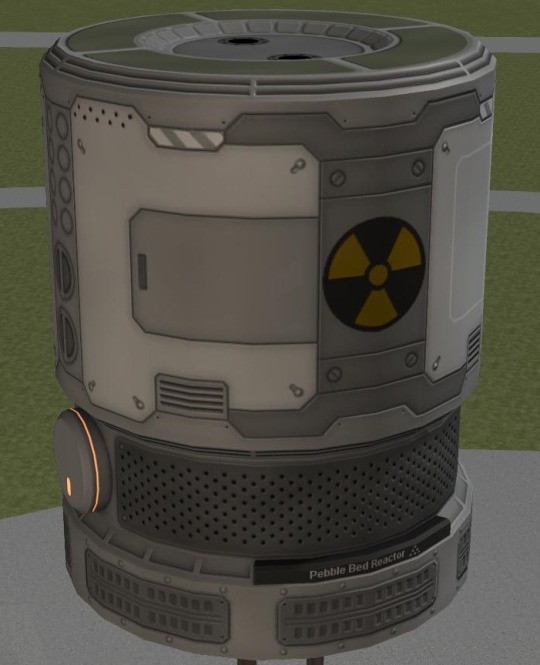
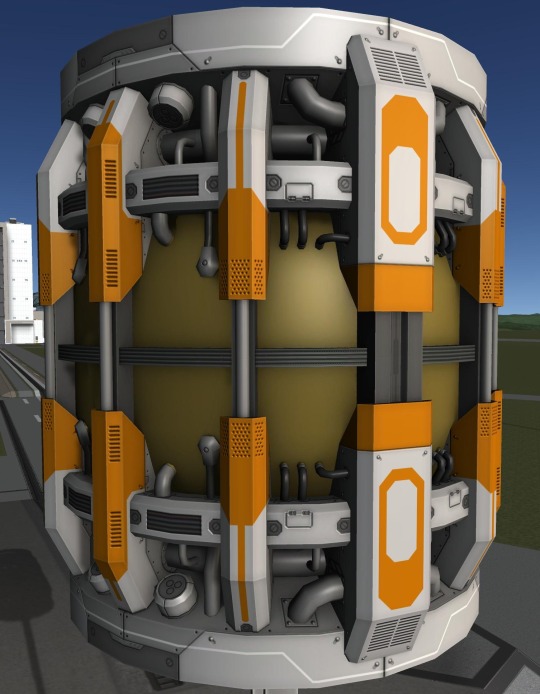
-

Matt Lowne has released Part 2 of the “Life on Laythe” series. Watch him send an impressive ocean base down to the moon’s waters, as well as a land-based station!





Carve your own KSP pumpkins with these spooky stencils!
in KSP1 The Daily Kerbal
Posted
Carve your own KSP pumpkins with these spooky stencils!